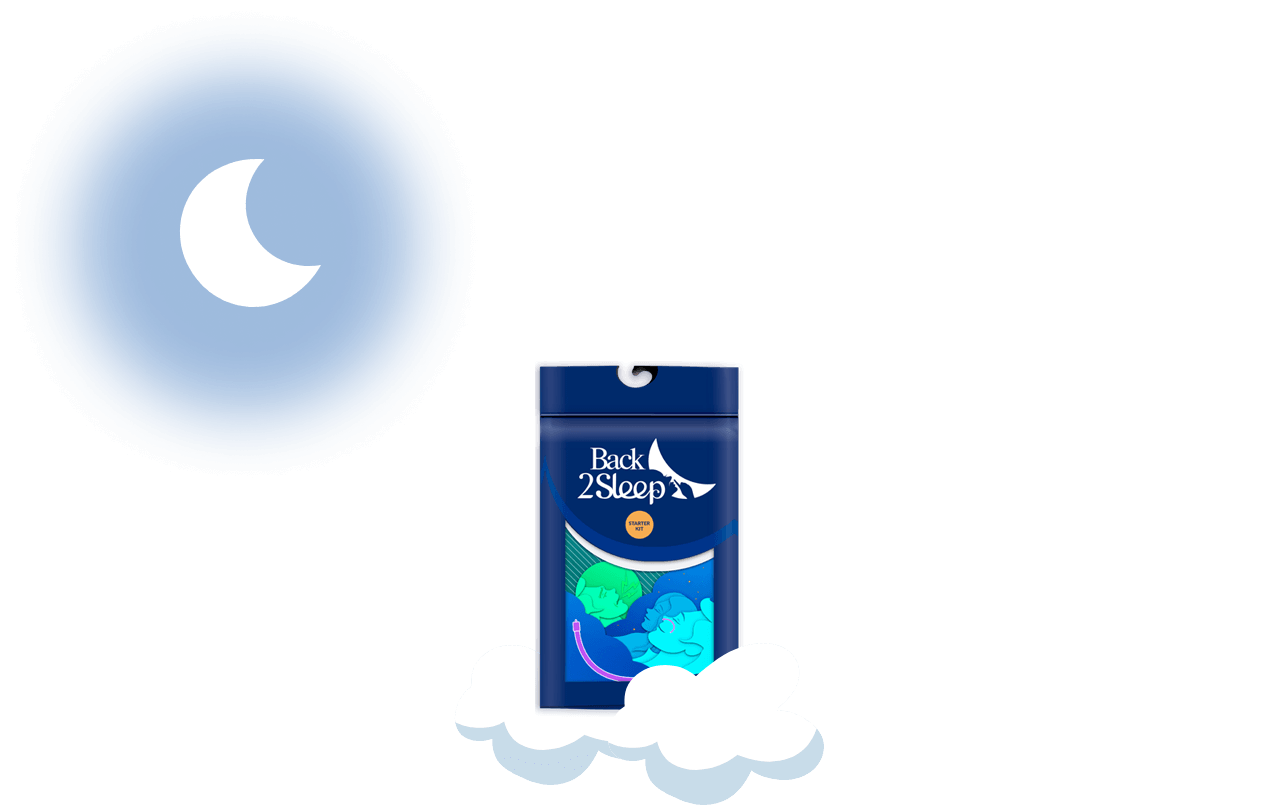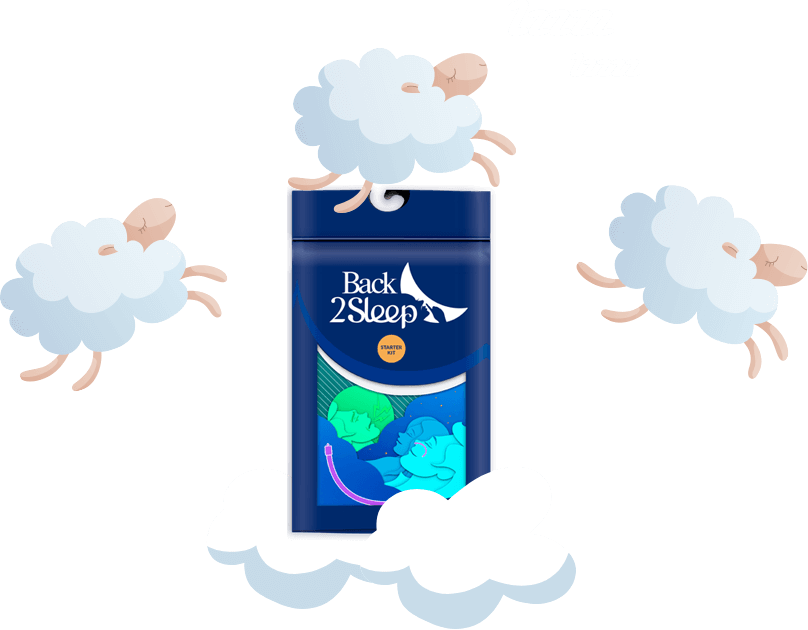Sleep Apnea: Complete Guide to Symptoms, Diagnosis & Effective Treatments in 2025
Discover how sleep apnea affects nearly 1 billion people worldwide and the proven solutions that can transform your sleep quality and protect your long-term health
Sleep apnea disrupts breathing repeatedly throughout the night, causing dangerous oxygen deprivation and fragmenting sleep in ways that devastate health and daily functioning. This severe sleep disorder, affecting over 936 million people globally with 80-90% remaining undiagnosed, goes far beyond simple snoring—it dramatically increases risks for heart attack, stroke, diabetes, and cognitive decline. Whether you're experiencing loud snoring, morning headaches, or crushing daytime fatigue, understanding sleep apnea symptoms and accessing effective treatments becomes critical for protecting both your immediate quality of life and long-term survival. From innovative nasal devices like Back2Sleep to CPAP therapy and surgical interventions, modern medicine offers powerful solutions to restore restorative sleep and prevent life-threatening complications.

Critical Health Alert: Recent 2025 studies estimate 83.7 million (32.4%) of US adults have sleep apnea, yet most remain undiagnosed. Untreated sleep apnea doubles heart attack risk and increases stroke likelihood by 86%.
The Global Sleep Apnea Crisis: 2025 Statistics That Demand Attention
The prevalence of sleep apnea has surged dramatically over the past two decades, primarily driven by the obesity epidemic. Current estimates suggest 425 million adults worldwide have moderate-to-severe sleep apnea requiring treatment, yet the vast majority never receive diagnosis or intervention. In the United States alone, 30 million people struggle with this condition, though only 6 million cases have been officially diagnosed.
Economic and Social Impact
Beyond health consequences, untreated sleep apnea creates massive economic burden. Individuals with undiagnosed sleep apnea incur 1.8 times higher healthcare costs before receiving proper diagnosis. Workplace productivity plummets, with affected workers showing significantly higher rates of job loss, reduced performance, and occupational injuries. Traffic accidents caused by sleep apnea-related drowsiness cost billions annually—losses that could be prevented through proper screening and treatment.
What Is Sleep Apnea? Understanding This Life-Threatening Disorder
Sleep apnea is a chronic medical condition characterized by repeated interruptions in breathing during sleep. These pauses, called apneic events, last 10 seconds or longer and occur when airways become blocked (obstructive sleep apnea) or when the brain fails to signal breathing muscles (central sleep apnea). Each breathing interruption triggers a survival reflex that briefly awakens you—often so quickly you don't remember it—preventing restful sleep and putting dangerous stress on your cardiovascular system.

The Three Types of Sleep Apnea
🫁 Obstructive Sleep Apnea (OSA)
The most common form (90%+ of cases), occurring when throat muscles relax during sleep, causing surrounding tissue to collapse and block the airway despite continued breathing effort.
🧠 Central Sleep Apnea (CSA)
Less common condition where the brain fails to send proper signals to breathing muscles, resulting in no breathing effort during sleep. Often linked to heart failure or neurological disorders.
🔄 Mixed Sleep Apnea
Also called complex sleep apnea syndrome, this combines features of both obstructive and central types, presenting unique diagnostic and treatment challenges.
📊 Severity Classification
Mild (5-15 events/hour), Moderate (15-30 events/hour), Severe (30+ events/hour). Severity determines appropriate treatment intensity and urgency.
How Sleep Apnea Disrupts Your Body
During each apneic event, oxygen levels in your blood drop while carbon dioxide accumulates. This intermittent hypoxia activates stress responses throughout your body: blood pressure spikes, heart rate becomes irregular, and inflammatory processes accelerate. Over time, these repeated cycles of oxygen deprivation and arousal inflict cumulative damage on cardiovascular, metabolic, and neurological systems.
Learn More About Sleep ApneaRecognizing Sleep Apnea Symptoms: Critical Warning Signs
Many people with sleep apnea remain completely unaware of their condition because key symptoms occur during sleep. Partner observations often provide crucial diagnostic clues that prompt medical evaluation. However, daytime symptoms also offer important indicators.
Nighttime Symptoms: What Happens While You Sleep
Daytime Symptoms: The Downstream Effects
Gender Differences in Symptoms: Women with sleep apnea more commonly report generalized symptoms like morning headaches, fatigue, insomnia, and mood changes rather than classic snoring. This contributes to underdiagnosis in women, whose risk approaches men's levels after menopause.

Life-Threatening Health Consequences of Untreated Sleep Apnea
Sleep apnea isn't merely an annoyance—it's a progressive disease that silently damages multiple organ systems. The cumulative effects of nightly oxygen deprivation, sleep fragmentation, and cardiovascular stress create a cascade of serious medical complications.
Cardiovascular Devastation
Cardiovascular disease represents the most dangerous consequence of untreated sleep apnea. The repeated stress of apneic events wreaks havoc on your heart and blood vessels:
Metabolic and Endocrine Disruption
Type 2 diabetes and sleep apnea share a bidirectional relationship. Up to 83% of people with Type 2 diabetes also have sleep apnea, while untreated sleep apnea independently increases diabetes risk through multiple mechanisms: insulin resistance worsens, glucose regulation deteriorates, and metabolic hormones become dysregulated. Sleep apnea also complicates weight management, creating a vicious cycle of worsening symptoms.
Neurological and Cognitive Decline
Research using neuroimaging reveals that severe, untreated sleep apnea causes measurable brain damage. Patients show significant reduction in white matter fiber integrity across multiple brain regions, accompanied by impairments in cognition, mood, and alertness. The encouraging news: one year of CPAP therapy leads to almost complete reversal of this brain damage. Functional and anatomical changes in brainstem regions also occur, affecting fundamental regulatory processes.
Mental Health Impact
A 2022 study of 182 sleep apnea patients found significantly increased prevalence of anxiety and depression, with 85 participants (47%) experiencing mental illness. Chronic sleep deprivation and intermittent hypoxia disrupt neurotransmitter balance, worsen existing psychiatric conditions, and create new mental health challenges. Irritability, mood swings, and personality changes strain relationships and reduce quality of life.
Surgical Risk Alert: Diagnosing sleep apnea and prescribing CPAP therapy prior to surgery significantly reduces postoperative cardiovascular complications—specifically cardiac arrest and shock—by more than half. Always inform surgical teams about sleep apnea diagnosis.
Who Gets Sleep Apnea? Understanding Your Risk Factors
While anyone can develop sleep apnea, certain factors dramatically increase susceptibility. Understanding these risk factors helps identify individuals who should pursue screening even without obvious symptoms.
| Risk Factor | Impact on Sleep Apnea Risk | Additional Details |
|---|---|---|
| Obesity (BMI ≥30) | 40% of obese individuals have sleep apnea | Excess tissue narrows airways; even 10% weight loss reduces events |
| Male Sex | 2x more likely than women | Risk equalizes for women post-menopause; progesterone protective |
| Age (65+) | 50% have at least mild OSA | Risk plateaus around age 60-70; 20% have moderate-severe |
| Neck Circumference | >17" men, >16" women increases risk | Larger neck often indicates more soft tissue in airway |
| Anatomical Features | Structural abnormalities obstruct airflow | Small/recessed jaw, large tonsils/adenoids, deviated septum |
| Family History | Genetic predisposition evident | OSA runs in families, suggesting hereditary components |
| Smoking | 340% higher risk | Inflammation and fluid retention narrow upper airways |
| Alcohol Use | 25% increased risk with heavy drinking | Relaxes throat muscles, worsening airway collapse |
| Nasal Congestion | Forces mouth breathing | Chronic allergies, structural issues increase likelihood |
Demographic Patterns and Disparities
Significant ethnic and racial disparities exist in sleep apnea prevalence. African Americans, Native Americans, and Hispanics show higher rates due to complex interactions of genetic predisposition, obesity prevalence, and socioeconomic factors affecting access to diagnosis and treatment. Children represent a special population, with 1-6% affected—often due to enlarged tonsils and adenoids—with obesity increasingly contributing to pediatric sleep apnea.
Diagnosing Sleep Apnea: From Suspicion to Confirmation
Accurate diagnosis requires comprehensive evaluation combining clinical assessment, symptom review, and objective sleep monitoring. Proper diagnosis guides treatment selection and establishes baseline severity for tracking improvement.
Clinical Evaluation Process
Step 1: Initial Consultation
Healthcare provider reviews symptoms, medical history, medication list, and family history. Physical examination assesses neck circumference, airway anatomy, nasal passages, tonsil size, and jaw alignment. Questionnaires like Epworth Sleepiness Scale quantify daytime drowsiness.
Step 2: Sleep Study Recommendation
Based on initial findings, provider recommends appropriate diagnostic testing. Options include in-laboratory polysomnography (gold standard) or home sleep apnea testing for suitable candidates.
Step 3: Polysomnography (PSG)
Overnight sleep study in specialized facility monitors brain waves, eye movements, heart rate, blood oxygen levels, breathing patterns, and muscle activity. Technicians observe throughout night, recording all physiological data.
Step 4: Results and Diagnosis
Sleep specialist analyzes data, calculating Apnea-Hypopnea Index (AHI)—the number of breathing disruptions per hour. AHI determines severity: Mild (5-15), Moderate (15-30), Severe (30+).
Home Sleep Apnea Testing (HSAT)
Advances in technology have made at-home sleep testing increasingly accessible. These portable devices record breathing patterns, oxygen saturation, heart rate, and body position while you sleep in your own bed. HSAT may be appropriate for individuals with high likelihood of moderate-to-severe OSA without significant comorbidities. Many insurance plans now require HSAT as preliminary testing before authorizing full polysomnography.
Split-Night Sleep Study: This efficient approach divides the night into two portions. The first half diagnoses sleep apnea; if confirmed, the second half tests CPAP pressure settings to optimize treatment. This reduces the need for multiple sleep studies.

Comprehensive Treatment Options: Finding Your Solution
Modern sleep medicine offers numerous evidence-based treatments ranging from conservative lifestyle modifications to advanced medical devices and surgical interventions. Treatment selection depends on sleep apnea type, severity, anatomical factors, comorbidities, and patient preferences. Many individuals achieve optimal results combining multiple approaches.
Lifestyle Modifications: Essential Foundation
For mild sleep apnea, behavioral changes may suffice as standalone treatment. Even in moderate-to-severe cases, lifestyle optimization significantly enhances effectiveness of medical therapies.
Positional Therapy
Sleeping position profoundly affects sleep apnea severity. Back sleeping (supine position) allows gravity to pull the tongue and soft palate backward, maximally obstructing airways. Side sleeping often reduces apnea events by 50% or more in position-dependent cases. Positional therapy devices, special pillows, or simple solutions like tennis balls sewn into pajama backs encourage side sleeping throughout the night.
Discover the Back2Sleep SolutionMedical Device Therapies: Proven Solutions
CPAP Therapy: The Gold Standard
Continuous Positive Airway Pressure (CPAP) remains the most prescribed and effective treatment for moderate-to-severe obstructive sleep apnea. The device delivers pressurized air through a mask worn during sleep, creating a pneumatic splint that keeps airways open.
CPAP effectiveness is unquestionable—when used consistently, it virtually eliminates apnea events, normalizes oxygen levels, and prevents cardiovascular complications. Clinical studies demonstrate dramatic improvements in daytime alertness, cognitive function, mood, and quality of life. Blood pressure reduces favorably in patients with resistant hypertension when CPAP therapy is properly implemented.
However, CPAP compliance challenges affect 30-50% of users. Common complaints include mask discomfort, claustrophobia, air pressure difficulty, noise (though modern machines are quieter), skin irritation, and travel inconvenience. Working closely with sleep specialists to address these issues—through mask refitting, pressure adjustments, heated humidification, and gradual desensitization—significantly improves long-term adherence.
Alternative PAP Therapies
Oral Appliances: Mandibular Advancement Devices
Custom-fitted dental devices reposition the lower jaw forward during sleep, enlarging the upper airway and reducing collapse likelihood. Oral appliances work best for mild-to-moderate OSA or as CPAP alternatives when patients cannot tolerate positive airway pressure. Success rates vary based on sleep apnea severity and individual anatomy, but properly fitted devices show 50-70% effectiveness in appropriate candidates. Regular dental follow-up ensures optimal fit and monitors for potential jaw or tooth movement.
Innovative Back2Sleep Nasal Stent Technology
For individuals seeking non-invasive alternatives without CPAP's bulk and complexity, the Back2Sleep intranasal orthosis offers a revolutionary approach. This CE-certified medical device consists of a soft, flexible silicone tube inserted into one nostril, extending to the soft palate region to prevent airway collapse during sleep.
⚡ Rapid Results
92% user satisfaction with noticeable snoring reduction and improved breathing from the very first night. No adjustment period required for most users.
🤫 Silent & Discreet
Completely noise-free operation, invisible to partners, and requires no electricity. Perfect for travel and maintaining intimate relationships.
📏 Customizable Fit
Four sizes (S, M, L, XL) ensure optimal comfort and effectiveness. Starter Kit allows trial of all sizes to identify perfect fit.
💰 Cost-Effective
Monthly replacement at €24.91-€35 costs significantly less than CPAP supplies and maintenance. No bulky equipment investment required.
Starter Kit
Complete introduction package with all four size options, allowing 15-night trial period to determine optimal fit.
- 4 nasal stents (S, M, L, XL)
- Natural nasal lubricant
- Detailed usage guide
- 15-day return policy
Monthly Subscription
Most popular option ensuring continuous supply with automatic delivery and free shipping throughout Europe.
- 2 stents monthly
- Your chosen size
- Free shipping
- Cancel anytime
Annual Plan
Maximum savings with year-round protection. Best value for committed users seeking long-term solution.
- 12 monthly deliveries
- €24.91 per unit
- Priority support
- Free shipping
Hypoglossal Nerve Stimulation
This implanted neurostimulation device represents cutting-edge sleep apnea treatment for individuals who cannot tolerate CPAP. Surgically placed in the upper chest, the device electrically stimulates the hypoglossal nerve, causing forward tongue movement timed with breathing. This prevents tongue-base collapse that obstructs airways during sleep. FDA-approved candidates typically have moderate-to-severe OSA with complete CPAP intolerance and specific anatomical features. Success rates reach 60-70% with sustained improvement over years.
Surgical Interventions: When Conservative Treatment Fails
Surgery becomes consideration when anatomical abnormalities directly cause sleep apnea, conservative treatments prove ineffective, or patients cannot tolerate other interventions. Surgical approaches vary based on obstruction location and severity.
Surgical outcomes depend critically on patient selection, obesity status, age, and anatomical factors. Younger patients (under 45) with BMI below 25 kg/m² and specific obstruction patterns show near-100% long-term success rates with appropriate procedures. However, surgery involves inherent risks, recovery time, and potential complications requiring careful discussion with experienced surgeons.
Living Successfully with Sleep Apnea: Long-Term Management
Sleep apnea requires lifelong management as a chronic condition. Success depends on treatment adherence, regular follow-up, addressing barriers to compliance, and adapting strategies as circumstances change.
Maximizing Treatment Adherence
Special Considerations
Driving safety requires attention when sleep apnea causes excessive daytime sleepiness. In many jurisdictions, you must inform licensing authorities about sleep apnea diagnosis and cannot drive until symptoms are controlled. Untreated sleep apnea dramatically increases motor vehicle accident risk—proper treatment could save billions annually in collision costs.
Pregnancy and sleep apnea deserve special mention. Up to 26% of pregnant women develop OSA by third trimester, with associated risks for gestational hypertension, preeclampsia, and gestational diabetes. Pregnant women experiencing snoring, witnessed apneas, or excessive fatigue should pursue evaluation.
Travel Tips: The Back2Sleep nasal stent's compact, electricity-free design makes it ideal for frequent travelers. Unlike CPAP machines requiring power adapters, carrying cases, and checked luggage space, the nasal stent fits in any pocket or purse.
Real Patient Experiences: Lives Transformed by Treatment
"My AHI was 27 and I used CPAP for 10 years. The nasal stent gave me my life back—no more bulky equipment when traveling, and my wife finally sleeps peacefully."
"I couldn't believe the difference after one year of CPAP therapy. My brain fog cleared, energy returned, and my blood pressure normalized. It saved my life."
"At first I didn't think anything would help, but the Back2Sleep device has been a game-changer. My snoring stopped immediately and I wake up actually refreshed."
Frequently Asked Questions About Sleep Apnea
Don't Let Sleep Apnea Steal Another Night
Join over 1 million people worldwide who have reclaimed restorative sleep and protected their long-term health with proven solutions.
Start Your Solution - €39✓ 92% satisfaction ✓ Immediate results ✓ 15-day guarantee
Take Control: Your Path to Better Sleep and Health
Sleep apnea affects nearly 1 billion people worldwide, yet 80-90% remain undiagnosed—silently suffering preventable health consequences. Recognition and treatment of this serious condition can literally save your life while dramatically improving daily functioning, relationships, and overall quality of life.
If you recognize symptoms in yourself or a loved one, don't wait for complications to develop. Pursue evaluation promptly through your healthcare provider or sleep specialist. Modern diagnostic tools make assessment straightforward, and treatment options now accommodate virtually any preference, lifestyle, or anatomical situation.
From lifestyle modifications and innovative devices like Back2Sleep to CPAP therapy and surgical interventions, effective solutions exist for every severity level. The key is taking that crucial first step: acknowledging the problem and seeking help.
Your health, your relationships, your safety, and your future depend on addressing sleep apnea today. The difference between struggling through exhausted days and experiencing true vitality lies in proper diagnosis and consistent treatment. Don't become another undiagnosed statistic—take control and reclaim the restorative sleep your body desperately needs.
Remember: Sleep apnea is not just snoring. It's a serious medical condition requiring professional diagnosis and treatment. Early intervention prevents life-threatening complications and restores quality of life. Start your journey to better sleep today.








